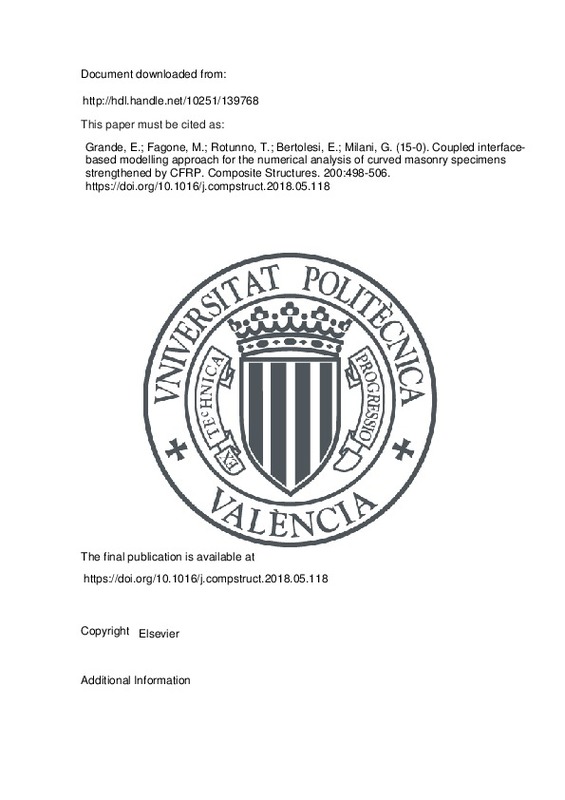JavaScript is disabled for your browser. Some features of this site may not work without it.
Buscar en RiuNet
Listar
Mi cuenta
Estadísticas
Ayuda RiuNet
Admin. UPV
Coupled interface-based modelling approach for the numerical analysis of curved masonry specimens strengthened by CFRP
Mostrar el registro sencillo del ítem
Ficheros en el ítem
| dc.contributor.author | Grande, Ernesto
|
es_ES |
| dc.contributor.author | Fagone, Mario
|
es_ES |
| dc.contributor.author | Rotunno, Tommaso
|
es_ES |
| dc.contributor.author | Bertolesi, Elisa
|
es_ES |
| dc.contributor.author | Milani, Gabriele
|
es_ES |
| dc.date.accessioned | 2020-03-30T07:22:05Z | |
| dc.date.available | 2020-03-30T07:22:05Z | |
| dc.date.issued | 2018-09-15 | es_ES |
| dc.identifier.issn | 0263-8223 | es_ES |
| dc.identifier.uri | http://hdl.handle.net/10251/139768 | |
| dc.description.abstract | [EN] Aim of the present paper is to numerically study the bond behavior of curved masonry specimens externally strengthened by Carbon Fiber Reinforced Polymer systems (CFRP). A simple 1D-modeling approach is presented to this aim, where the coupled behavior between shear and normal stresses developing at the reinforcement/masonry interface level is specifically introduced to properly account for the role played by the curvature radius. The model is indeed enriched by the introduction of shear stress-slip laws able to account for the beneficial friction effect, when compression normal stresses develop at the interface level and the reduction of the slip strength corresponding to the de-cohesion in presence of normal stresses in tension. Considering some case studies derived from the current literature, consisting of shear-lap bond tests of curved masonry specimens characterized by different curvatures of the bonded surface and different strengthening configurations, the validation of the proposed approach is carried out. In particular, two modeling strategies are considered and critically compared: the first one, denoted as approach (A), where the presence of the mortar joints is neglected, and the second one, denoted as approach (B), where mortar joints are specifically introduced in the model. Finally, the results obtained by using the proposed simple approach are compared with those obtained from both sophisticated FE numerical models and theoretical formulas deduced from the current literature. | es_ES |
| dc.language | Inglés | es_ES |
| dc.publisher | Elsevier | es_ES |
| dc.relation.ispartof | Composite Structures | es_ES |
| dc.rights | Reserva de todos los derechos | es_ES |
| dc.subject | FRP | es_ES |
| dc.subject | Masonry curved structures | es_ES |
| dc.subject | FE modeling | es_ES |
| dc.subject | Delamination | es_ES |
| dc.subject | 1D coupled interface model | es_ES |
| dc.title | Coupled interface-based modelling approach for the numerical analysis of curved masonry specimens strengthened by CFRP | es_ES |
| dc.type | Artículo | es_ES |
| dc.identifier.doi | 10.1016/j.compstruct.2018.05.118 | es_ES |
| dc.rights.accessRights | Abierto | es_ES |
| dc.description.bibliographicCitation | Grande, E.; Fagone, M.; Rotunno, T.; Bertolesi, E.; Milani, G. (2018). Coupled interface-based modelling approach for the numerical analysis of curved masonry specimens strengthened by CFRP. Composite Structures. 200:498-506. https://doi.org/10.1016/j.compstruct.2018.05.118 | es_ES |
| dc.description.accrualMethod | S | es_ES |
| dc.relation.publisherversion | https://doi.org/10.1016/j.compstruct.2018.05.118 | es_ES |
| dc.description.upvformatpinicio | 498 | es_ES |
| dc.description.upvformatpfin | 506 | es_ES |
| dc.type.version | info:eu-repo/semantics/publishedVersion | es_ES |
| dc.description.volume | 200 | es_ES |
| dc.relation.pasarela | S\374825 | es_ES |







![[Cerrado]](/themes/UPV/images/candado.png)

